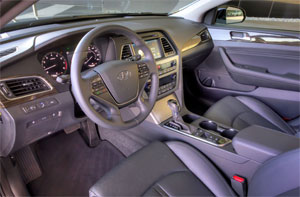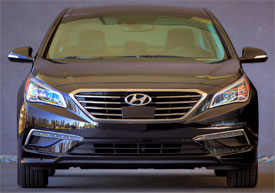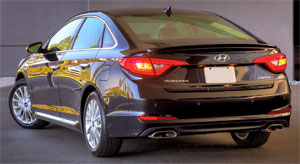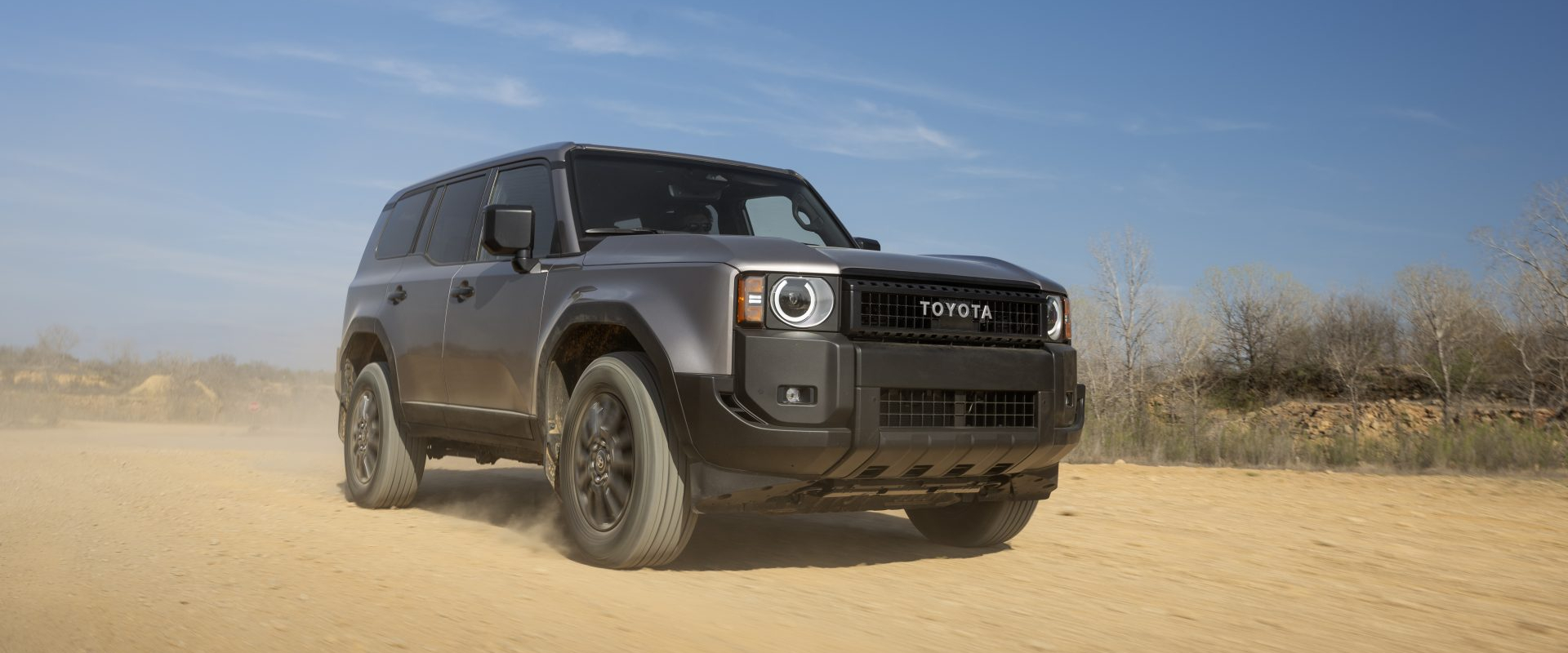2015 Hyundai Sonata
The 2011 Sonata was a watershed sedan for Hyundai. It lured buyers in with dynamic styling, and cheap prices, and kept them satisfied with great drivability and reliability. But, that was yesterday. The challenge today is to keep those buyers despite more intense mid-size competition, and to uphold their well-earned reputation. So let’s find out how an all-new 2015 Sonata measures up.
It’s difficult to fathom that the 2015 Hyundai Sonata marks the beginning of the 7th generation of the Korean middle-weight four-door. To say it has come a long way is an understatement. Evolving from a late 80’s boxy also ran, to today’s family sedan trend setter.
And it’s easy to see those trend setting ways continuing when you climb inside the latest Sonata. You’re immediately treated to a great looking interior that is incredibly comfortable and very upscale in feel. Though this Limited model’s rich 2-tone black and brown theme surely has a lot to do with that.
Not that it’s perfect. Some of our staff found the sparseness of control knobs annoying, and the few knobs that are present are either a long reach or look too similar to each other, and had some turning up the temperature when they we were trying to crank up the volume. Owners will likely figured it all out in no time, however.
 The folding rear seats offer plenty of head and leg room, and while seat cushions are a little on the hard side there is a very comfortable rake to the seat backs which makes things quite tolerable for long trips.
The folding rear seats offer plenty of head and leg room, and while seat cushions are a little on the hard side there is a very comfortable rake to the seat backs which makes things quite tolerable for long trips.
In fact, interior volume has risen enough that Sonata is now in the Large Car EPA size-class. Trunk space is certainly larger than most mid-size rivals at 16.3 cubic-ft.
An available Tech package gets you a panoramic sunroof, HID headlights, and very competent 8-inch navigation display with touchscreen. But the Ultimate package is where the tech really kicks in with smart cruise control with full stop and start capabilities, lane departure warning, forward collision warning, plus an electronic parking brake with hold feature.
As before all engines are four-cylinder and three are available. This standard, direct-injected 2.4-liter I4 rates 185-horsepower and 178 lb-ft. of torque. Peak power is actually down a little from last year in an attempt to make things more responsive. But, we found it a bit weak and noisy. A 1.6-liter turbo Eco model is new, but only recommended if fuel economy is your number-one priority. The 245-horsepower 2.0-liter turbo looks like the best choice for ample off-the line torque.
 We didn’t find that in the 2.4. Getting to 60 took us a lackluster 9.3-seconds. Well off the previous car. You do start to feel some hint of power mid-range, but slow shifts from the 6-speed automatic keep the fun factor just barely above zero. Running out the ¼-mile took 17.2-seconds at 83 miles-per-hour.
We didn’t find that in the 2.4. Getting to 60 took us a lackluster 9.3-seconds. Well off the previous car. You do start to feel some hint of power mid-range, but slow shifts from the 6-speed automatic keep the fun factor just barely above zero. Running out the ¼-mile took 17.2-seconds at 83 miles-per-hour.
Things improved somewhat through our handling course. Understeer is certainly there, but it doesn’t bombard you. Steering is quick, but the feel is artificially heavy and disconnected. Much, much better was braking performance, with solid stops from 60 that averaged just 117-feet.
This is, first and foremost, a family sedan of course, so while it’s doubtful that track performance will be high on any family’s priority list, exterior design will certainly play a much larger roll.
The fluidic sculpture 2.0 styling theme tries just as hard as the previous generation to make a statement, but we’re not sure the results are nearly as successful. Though the look, complete with LED daytime running lights and dual exhaust is now undoubtedly classier, like its better rivals. The rear appears wider and taller, with high mounted LED tail lights pointing in towards the center.
So while exterior beauty is always in the eye of the beholder, from the driver’s seat we all agree that Hyundai has certainly come a long way in chassis and suspension refinement. Ride is both solid and smooth. We also appreciated the lack of CVT transmission and found the 6-speed manual-mode automatic to work very well in daily driving.
 It proved quite efficient for a larger sedan as well, with Government Fuel Economy Ratings of 25-City, 37-Highway, and 29-Combined, which we matched almost perfectly with a 29.2 miles-per-gallon loop on Regular. The Energy Impact Score is also respectable with 11.4-barrels of oil burned annually and 5.1-tons of CO2 emitted.
It proved quite efficient for a larger sedan as well, with Government Fuel Economy Ratings of 25-City, 37-Highway, and 29-Combined, which we matched almost perfectly with a 29.2 miles-per-gallon loop on Regular. The Energy Impact Score is also respectable with 11.4-barrels of oil burned annually and 5.1-tons of CO2 emitted.
One thing that has not changed is Hyundai value with Sonata’s base pricing of just $21,960. Limited trim will cost you a fair bit more, but is still a bargain at $27,335. And of course Hyundai’s America’s Best Warranty is still in effect.
There is nothing that feels cheap about the 2015 Hyundai Sonata, particularly in upscale Limited guise, as it fully showcases the brand in their growth from low price alternative to mainstream staple. 7-generations is certainly proof that this car is more contender than pretender, and carmakers will be trying to out-do this high value nameplate for a years to come.
Specifications
- Engine: 2.4-liter
- Horsepower: 185
- Torque: 178 lb-ft.
- 0-60 mph: 9.3 seconds
- 1/4 mile: 17.2 seconds @ 83 mph
- EPA: 25 mpg city/ 37 mpg highway
- Energy Impact: 11.4 barrels of oil/yr
- CO2 Emissions: 5.1 tons/yr
2024 Toyota Land Cruiser
Toyota’s Go Anywhere Globetrotter Returns To U.S.
Every once in a while, we all need a reset. A time to get back to basics and prioritize the things that really matter. Well, for the Toyota Land Cruiser that time is now. So, let’s find out if that means bigger and better things for Toyota’s iconic off-roader.
The Toyota Land Cruiser’s status among the global off-road community is legendary, and it’s hard to imagine there’s any corner of the earth where a Land Cruiser hasn’t kicked up a little dust or mud. Well, 2024 sees the return of the Land Cruiser to the U.S. market after a 3-year hiatus, getting a major reset for the journey.
The reset comes mostly by no longer being based on the large three-row “300-series” chassis, but a new version of the smaller “200-series,” now known as the J250. As with the latest Tacoma, it uses the Tundra pickup’s full-size steel frame.
While the main Land Cruiser model, which goes by simply Land Cruiser, is packed full of luxury and convenience features, there is also a stripped-down model known as the 1958, honoring the first year the Land Cruiser made landfall here in North America. And it is that 1958 we have here, and we were glad to see it, as it also celebrates the original’s back-to-basics approach as a blank canvas for you to personalize as you tackle more and more adventures.
Not that it’s fully stripped down, as 8-inch touchscreen infotainment, a 7-inch full-color multi-information display, and automatic climate control are still standard. Plus, some seriously durable materials, and great heated cloth front seats that throw off some get serious 1990s Tacoma vibes.
But outside, there’s a definite lack of flashy trim and basic looking 18-inch wheels with Yokohama Geolander all-season tires; plus, big chunky bumpers and tilt-up back glass, which is a rarity that we appreciate. Though there is a little too much plastic in places that are sure to see some abuse if you do any significant off-roading.
It even feels a little rough around the edges, but for us it just adds to the rugged old-school utility vibe in a good way.
We did just that, both here in the Mid-Atlantic as well as in the California desert; and while there are some tech-forward driving aids, the actual hardware is in most cases plenty to get things done. That includes standard full-time dual-range four-wheel-drive, locking center and rear diffs, and 8.7-inches of ground clearance. A front stabilizer bar disconnect is also available to allow for increased articulation.
Who needs a V6 or even a V8 when you’ve got Toyota’s i-FORCE MAX setup at your disposal with 326 horsepower and 465 lb-ft of torque coming from a 2.4-liter turbo-four with an electric motor sandwiched between the engine and its eight-speed automatic transmission. Low speed torque delivery is impressive. It even feels a little rough around the edges, which may be a turn off to some, but for us it just adds to the rugged old-school utility vibe in a good way.
And it certainly feels quicker than an off roader needs to be, with an instant torque dump as soon as we eased on the throttle at our Mason Dixon test track; helping us get to 60 in 8.1 seconds and through the quarter-mile in 16.3 seconds at 86 mph. Considering the Land Cruiser’s terrain conquering mission, it behaved quite well in our handling course; it was plenty responsive to inputs, with less body roll than we expected and plenty of grip from the tires. The steering was light and quick but as expected didn’t provide much feel. Other than significant nosedive, braking performance was exceptional. Only 107-feet to panic stop us from 60 mph.
With the shift to the smaller size, there’s no more third row available, and cargo capacity now comes in at 46.2 cubic-feet with a max of a still healthy 82.1. Now, the best part of the Land Cruiser’s return is the entry price of $57,445. That’s about 30-grand less than what the last Land Cruiser went for back in 2021.
Whether it’s over the top fashion trends, mullets, or zombies; just when you think they’re dead, they come roaring back to life. Of course, we’re much happier to see the resurrection of this 2024 Toyota Land Cruiser than any of those things. Toyota is one brand that still recognizes the value of full-framed rugged rigs and has also acknowledged that sometimes less really is more. The Godfather of Toyota off-roading is back and better than ever.







